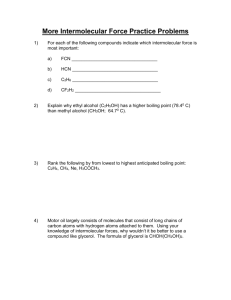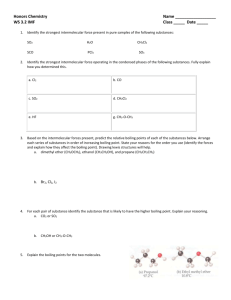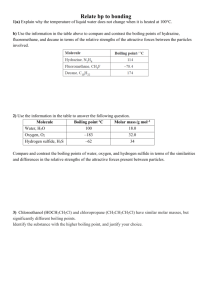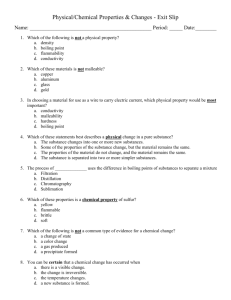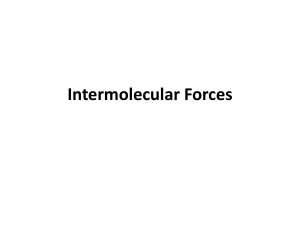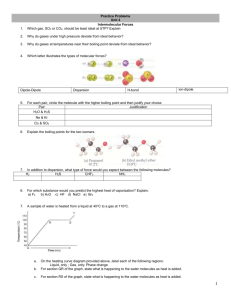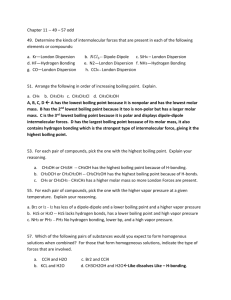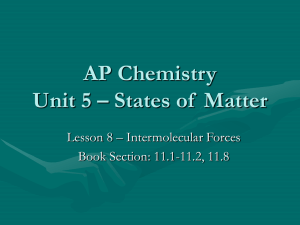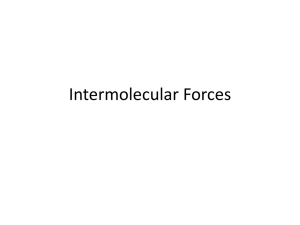Section 11.1-11.3 List the characteristics for each state of matter
advertisement
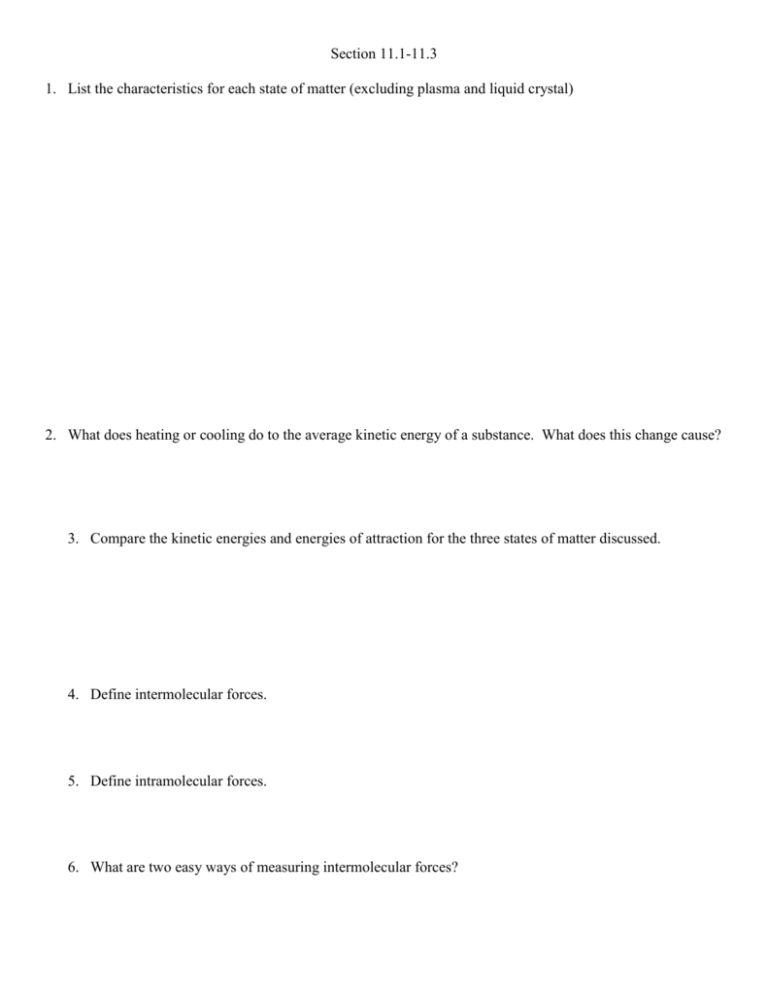
Section 11.1-11.3 1. List the characteristics for each state of matter (excluding plasma and liquid crystal) 2. What does heating or cooling do to the average kinetic energy of a substance. What does this change cause? 3. Compare the kinetic energies and energies of attraction for the three states of matter discussed. 4. Define intermolecular forces. 5. Define intramolecular forces. 6. What are two easy ways of measuring intermolecular forces? 7. Define van der Waals forces. 8. What is the trend of melting/boiling points for the different bond types. (Polar covalent, nonpolar covalent, ionic, van der Waals, etc) 9. Draw what dispersion forces look like. (Figure 11.4) 10. Define polarizability. 11. Define Dispersion force 12. Do dispersion forces increase of decrease with increasing molecular size (mass)? 13. Draw attractive and repulsive dipole-dipole forces. 14. As polarity increases what happens to boiling point. 15. Define hydrogen bonding. 16. In which of these substances is hydrogen bonding likely to play an important role in determining physical properties: methane (CH4), hydrazine (H2NNH2), methyl fluoride (CH3F), hydrogen sulfide (H2S)? 17. Define ion-dipole force 18. Are dispersion forces found in all substances? Explain why. 19. What two generalizations can be made when considering intermolecular attractions? 20. Draw the flowchart for determining intermolecular forces. 21. List the substances BaCl2, H2, CO, HF, and Ne in order of increasing boiling point. 22. Define viscosity. Give the SI unit for it. 23. Viscosity is related how to chain length of hydrocarbons? 24. Define surface tension. 25. Define capillary action. 26. Why does mercury have an inverse meniscus to that of water? 27. List the three states of matter in order of (a) increasing molecular disorder and (b) increasing intermolecular attraction. (c) Which state of matter is most easily compressed? 28. As a metal such as lead melts, what happens to (a) the average kinetic energy of the atoms, (b) the average distance between the atoms? 29. At standard temperature and pressure the molar volumes of Cl2 and NH3 gases are 22.06 and 22.40 L, respectively. (a) Given the different molecular weights, dipole moments, and molecular shapes, why are their molar volumes nearly the same? (b) On cooling to 160 K, both substances form crystalline solids. Do you expect the molar volumes to decrease or increase on cooling the gases to 160 K? (c) The densities of crystalline Cl2 and NH3 at 160 K are 2.02 and 0.84 g/cm3, respectively. Calculate their molar volumes. (d) Are the molar volumes in the solid state as similar as they are in the gaseous state? Explain. (e) Would you expect the molar volumes in the liquid state to be closer to those in the solid or gaseous state? 30. (a) Which type of intermolecular attractive force operates between all molecules? (b) Which type of intermolecular attractive force operates only between polar molecules? (c) Which type of intermolecular attractive force operates only between the hydrogen atom of a polar bond and a nearby small electronegative atom? 31. Describe the intermolecular forces that must be overcome to convert these substances from a liquid to a gas: (a) SO2, (b) CH3COOH, (c) H2S. 32. (a) What is meant by the term polarizability? (b) Which of the following atoms would you expect to be most polarizable: N, P, As, Sb? Explain. (c) List the following molecules in order of increasing polarizability: GeCl4, CH4, SiCl4, SiH4, and GeBr4. (d) Predict the order of boiling points of the substances in part (c). 33. Which member in each pair has the greater dispersion forces? (a) H2O or H2S, (b) CO2 or CO, (c) SiH4 or GeH4. 34. Butane and 2-methylpropane, whose space-filling models are shown here, are both nonpolar and have the same molecular formula, C4H10, yet butane has the higher boiling point (-0.5 °C compared to -11.7 °C). Explain. 35. (a) What atoms must a molecule contain to participate in hydrogen bonding with other molecules of the same kind? (b) Which of the following molecules can form hydrogen bonds with other molecules of the same kind: CH3F, CH3NH2, CH3OH, CH3Br? 36. Ethylene glycol (HOCH2CH2OH), the major substance in antifreeze, has a normal boiling point of 198 °C. By comparison, ethyl alcohol (CH3CH2OH) boils at 78 °C at atmospheric pressure. Ethylene glycol dimethyl ether (CH3OCH2CH2OCH3) has a normal boiling point of 83 °C, and ethyl methyl ether (CH3CH2OCH3) has a normal boiling point of 11 °C. (a) Explain why replacement of a hydrogen on the oxygen by a CH3 group generally results in a lower boiling point. (b) What are the major factors responsible for the difference in boiling points of the two ethers? 37. Look up and compare the normal boiling points and normal melting points of H2O and H2S. Based on these physical properties, which substance has stronger intermolecular forces? What kinds of intermolecular forces exist for each molecule? 38. A number of salts containing the tetrahedral polyatomic anion, BF4-, are ionic liquids, whereas salts containing the somewhat larger tetrahedral ion SO42- do not form ionic liquids. Explain this observation. 39. (a) What is the relationship between surface tension and temperature? (b) What is the relationship between viscosity and temperature? (c) Why do substances with high surface tension also tend to have high viscosities? 40. Explain the following observations: (a) The surface tension of CHBr3 is greater than that of CHCl3. (b) As temperature increases, oil flows faster through a narrow tube. (c) Raindrops that collect on a waxed automobile hood take on a nearly spherical shape. (d) Oil droplets that collect on a waxed automobile hood take on a flat shape. 41. The boiling points, surface tensions, and viscosities of water and several alcohols are as follows: (a) For ethanol, propanol, and n-butanol the boiling points, surface tensions, and viscosities all increase. What is the reason for this increase? (b) How do you explain the fact that propanol and ethylene glycol have similar molecular weights (60 versus 62 amu), yet the viscosity of ethylene glycol is more than 10 times larger than propanol? (c) How do you explain the fact that water has the highest surface tension but the lowest viscosity?
